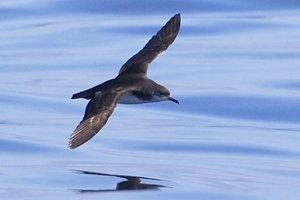Manx shearwater
 The Manx shearwater is a quizzical bird in many ways! If you are ever planning questions for a pub quiz – think Manx shearwater!
The Manx shearwater is a quizzical bird in many ways! If you are ever planning questions for a pub quiz – think Manx shearwater!
Question 1: What bird goes by the scientific name Puffinus puffinus? Everyone will assume it is, of course, the puffin. However, it is not – it is the Manx shearwater! (The puffin’s scientific name is in fact Fratercula arctica.)
Question 2: What is the oldest recorded living wild British bird? One would assume that a really large bird such as a mute swan or a golden eagle might hold such a title – but no, it is the comparatively smaller Manx shearwater. An adult bird was caught and ringed on Bardsey Island on 17 May 1957 and was recaptured (still alive and well!) back on Bardsey Island on 8 May 2008. This makes it at least 50 years, 11 months and 21 days old! I say “at least” because when ringed it was probably about five years old, the age that these shearwaters start to breed - which is why it was back on Bardsey!
Question 3: What British bird has flown well over 5 million miles in its lifetime? Well, this Bardsey individual will spend each winter in the south Atlantic, probably somewhere off Brazil or Argentina, making it a round trip of 12,000 miles back to Bardsey Island. So, just in the confirmed 50 years that it has lived, it will have travelled well over 5 million miles, covering some 600,000 miles just on migration. Indeed, these birds seem to love flying! One youngster, obviously taking a gap year, was found dead on the south coast of Australia, 10,361 miles from its ringing site on Skomer Island, Dyfed, where it had been ringed as a fledgling 1 year, 2 months and 13 days earlier.
Question 4: What made Norse sailors think that the Scottish island of Rum was inhabited by trolls? Well, of course it was the Manx shearwater!
During March these birds begin to return to their breeding colonies, usually based on offshore islands mainly off the west coast of Scotland and Wales, which are free of rats and other ground predators. The largest ever colony used to be found on the Isle of Man, hence Manx shearwater. However, it was destroyed by rats about 200 years ago.
The colonies are located on steep, grassy slopes, where they nest in old rabbit burrows. When not out at sea feeding, they will hide away in their burrows for most of the day, until night falls when they will head out to sea. Manx shearwaters that have spent the day out hunting fish and squid don’t like coming onto land until it is dark, so they will group together on the sea, forming what are called ‘rafts’. There they will wait until night falls before returning to their burrows.
Once darkness falls, the whole colony starts to call; an eerie mix of shrieking, cooing and rasping cries fill the darkness. In amongst this noisy mayhem, individual birds can recognise their mate’s distinctive individual call emanating from the home burrow, and so land at the correct entrance. No wonder big burly Norsemen thought that the isle of Rum was full of strange troll-like creatures, and chose not to land there!
All these centuries later, the Manx shearwater remains a mysterious, magical species. I expect science may well unravel more amazing facts in the coming years about this traveller of the seas, some of which may land up as a future pub quiz question!
Peter Thompson
Advisory
Read more from Peter Thompson at his blog.
Photo credit: Matt Witt

Download Peter Thompson's essential 26-page book, featuring beautiful photography and detailed profiles of Britain's wildlife
Download FREE >